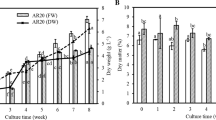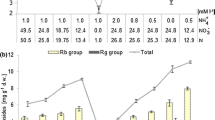Abstract
HPLC analysis of extracts of different parts of two six-year-old Panax ginseng (Ginseng & Tobacco Company, South Korea) plantation roots demonstrated the presence of seven detectable ginsenosides (Rb1, Rb2, Rc, Rd, Rf, Rg1, and Re). The total contents were 1.16 and 0.64% for main roots, 4.00 and 4.60% for rhizomes, 6.79, 4.38% for side roots (d = 0.4–0.5 cm), and 13.26 and 11.37 for fine roots (d = 0.1–0.15 cm). Four new ginseng callus lines were originated from side and fine roots. HPLC analysis of the qualitative and quantitative composition of the biomass after the first year of cultivation showed that all lines contained the full spectrum of ginsenosides (Rb1, Rb2, Rc, Rd, Rf, Rg1, and Re), the total content of which varied from 0.2 to 0.4%. HPLC monitoring of these callus lines over five years of cultivation demonstrated gradual disappearance of glycosides Rb2, Rc, Rd, and Rf from the ginsenoside spectrum. Loose calluses growing in medium containing 0.5 and 0.2 mg-liter 6-benzylaminopurine were used to start suspension cultures L-1 and L-2, respectively. HPLC analysis of the qualitative and quantitative composition of glycosides in suspension cultures showed that both lines contained only ginsenosides Rb1, Rg1, and Re, with a predominance of Re ginsenoside.
Similar content being viewed by others
References
F. C. Lee, Facts about Ginseng. The Elixir of Life, Seoul, Korea (1992).
D. Washida and S. Kitanaka, Enz. Microbiol. Techn., 32(3–4), 498–503 (2003).
I. V. Grushvitskii, B. K. Pushkin, and D. A. Murav’eva, Our Magician Ginseng. Legends and Facts [in Russian], Omsk (1989).
O. Tanaka, Pure Appl. Chem., 62(7), 1281–1284 (1990).
N. I. Uvarova, G. V. Makhank’kov, G. V. Malinovskaya, et al., Khim.-Farm. Zh., 34(3), 19–25 (2000).
R. G. Butenko, Cultures of Isolated Tissues and the Physiology of Plants Morphogenesis [in Russian], Nauka, Moscow (1964).
N. A. Konstantinova, V. V. Makhan’kov, N. I. Uvarova, et al., Khim. Prirod. Soedin., No. 6, 808–813 (1991).
A. Mathur, A. K. Mathur, M. Pal, and G. C. Uniyal, Planta Med., 65(5), 484–486 (1999).
K. T. Choi, I. O. Akhn, and D. S. Pak, Fiziol. Rast., 41(6), 784–788 (1994).
O. V. Reshetnyak, I. E. Knyaz’kov, I. N. Smolenskaya, et al., Biotekhnol., No. 2, 69–75 (2003).
M. Kubo, T. Tani, T. Katsuki, et al., J. Nat. Prod., 43, No. 2, 278–274 (1980).
K. Samukawa, H. Yamashita, H. Matsuda, and M. Kubo, Yakugaku Zasshi., 115(3), 241–249 (1995).
State Pharmacopeia, Meditsina, Moscow (1987), XI edition, No. 1, pp. 285–286.
M. Suzuki, K. Nakagava, H. Fukui, and M. Tabata, Plant Cell Rep., 6, 260–263 (1987).
E. J. Staba, Proc. Proc. Proc. Y. Intern. Congr. Plant Tissue & Cell Culture, Tokyo (1982), pp. 25–30.
Author information
Authors and Affiliations
Additional information
__________
Translated from Khimiko-Farmatsevticheskii Zhurnal, Vol. 42, No. 1, pp. 33–38, January, 2008.
Rights and permissions
About this article
Cite this article
Reshetnyak, O.V., Chernyak, N.D., Smolenskaya, I.N. et al. Comparative analysis of ginsenosides in different root parts and cultured cells from Chinese ginseng. Pharm Chem J 42, 32–36 (2008). https://doi.org/10.1007/s11094-008-0052-7
Received:
Published:
Issue Date:
DOI: https://doi.org/10.1007/s11094-008-0052-7




